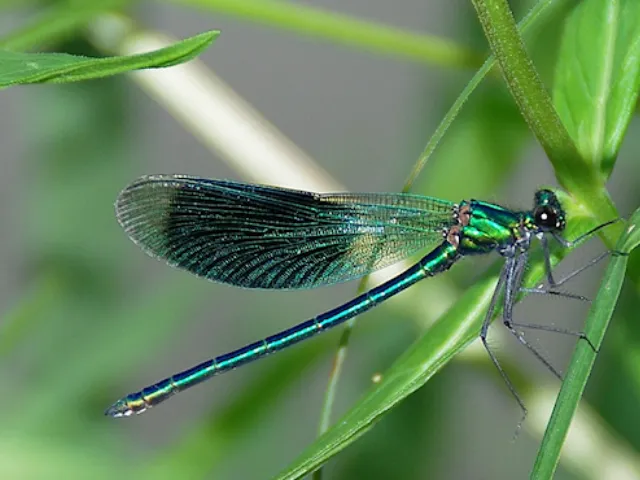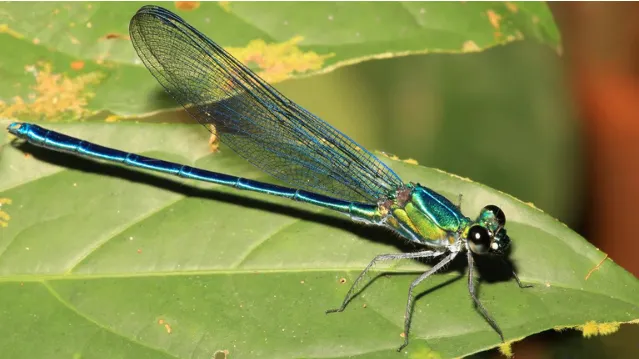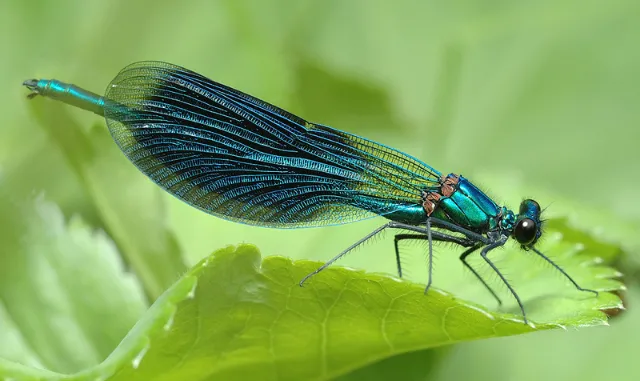Greetings Insect World lovers.
Saludos amantes del Mundo de los Insectos.
Hello, this is my post #2 in the wonderful Insects of the World Community?. Last week when I was on a trip walking to get to the river I found a beautiful and attractive insect which I started to investigate about it. And today I will talk to you and tell you about the curious facts of this wonderful insect.
.Hola esta es mi publicación #2 en la maravillosa Comunidad de Insectos del Mundo?. La semana pasada cuando estaba de viaje caminado para llegar al río me encontré un insecto hermoso y atractivo el cual me puse a investigar sobre él. Y el día de hoy les hablaré y les contare sobre los datos curiosos de este maravilloso insecto.

Photo source: https://www.hippopx.com/sl/dragonfly-demoiselle-insect-macro-close-nature-light-170782

Calopterix virgo or commonly known as blue damselflies, live mainly near small streams. They prefer water with low temperature and moderate to fast flow.Blue damselflies (Calopterix virgo), are often confused with dragonflies. But, the two groups have one major difference; calopterix virgo hold their wings together when at rest, while dragonflies hold their wings horizontally apart.
Los Calopterix virgo o comúnmente conocidos como caballito del diablo azul, vive principalmente cerca de pequeñas corrientes de agua. Prefieren una agua con baja temperatura y un flujo moderado o rápido.Los caballitos del diablo azul (Calopterix virgo), se confunden a menudo con las libélulas. Pero, ambos grupos tienen una gran diferencia; los calopterix virgo mantienen las alas juntas cuando están en reposo, mientras que las libélulas las mantienen separadas horizontalmente.

Photo source: https://pixabay.com/es/photos/lib%C3%A9lula-5203708/

Their diet consists of all types of insects, including mosquitoes, ants and termites, and sometimes even others of their own species. They are dependent on aquatic plants. The larvae need the stems and leaves, especially in fast flowing areas, to support themselves. It would be very rare to find them within sterile locations or areas with a smooth stone bottom. They mostly live in quiet areas such as fallen leaves or roots of vegetation. The life cycle of blue damselflies, from the egg stage to death as adults, ranges from six months to six to seven years. Incredible, isn't it?
Su alimentación consiste en todo tipo de insectos, incluyendo mosquitos hormigas y termitas e incluso en algunas ocasiones otras de su propia especie. Son dependientes de las plantas acuáticas. Las larvas necesitan los tallos y hojas, especialmente en áreas corrientes rápidas para aguantarse. Sería muy raro encontrarlas dentro de ubicaciones estériles o áreas con un fondo de piedra liso. Mayormente viven en áreas tranquilas como en hojas caídas o en raíces de la vegetación.El ciclo de vida de los caballitos del diablo azul, desde la fase de huevo hasta la muerte en edad adulta, abarca entre seis meses, hasta seis o siete años. Increíble verdad?

Photo source: https://www.sciencemag.org/news/2015/12/explosion-new-dragonfly-species-results-animals-named-after-gorillas-pink-floyd

Acrobats of the air: With their wings they reach speeds of 72 kilometers per hour, making only 30 flaps per minute, a speed similar to that of a hummingbird's flapping wings.
Excellent vision: Each eye has about 28,000 individual units called ommatidias. This gives them excellent all-around vision.
Long distance travel: Capable of long flights of more than 17000 km.
They bite: Their mouths are made to bite; making them very good hunters.
Dragonflies are wonderful ancestral insects: Before dinosaurs existed on Earth, blue damselflies and dragonflies were already flying in the skies. They could measure more than 72 cm from wingtip to wingtip!
They copulate in mid-flight: Dragonflies are able to copulate in mid-flight, usually lasting a few seconds or minutes.
Good water: The presence of blue damselflies in rivers indicates good water conditions.
Acróbatas del aire: Con sus alas alcanzan velocidades de 72 kilometros por hora solo realizando unas 30 aleteadas por minuto, haciendo una velocidad parecida al del aleteo de un colibrí.
Excelente visión: Cada ojo tiene unas 28000 unidades individuales que se les llama ommatidias. Esto hace que tengan una excelente visión de todo.
Recorren largas distancias: Capaces de realizar vuelos largos de más de 17000 km.
Muerden: Sus bocas están hechas para morder; haciéndolas unas cazadoras mu buenas.
Las libélulas son maravillosos insectos ancestrales: Antes de que los dinosaurios existieran en la Tierra, los caballitos del diablo azul y las libélulas ya sobrevolaban los cielos. Podían llegar a medir más de 72 cm de punta a punta de ala!
Copulan en pleno vuelo: Las libélulas son capaces de copular en pleno vuelo, suele durar algunos segundos o minutos.
Agua Buena: La presencia de caballitos del diablo azul, en ríos indican del buen estado de las aguas.

Photo source: https://www.dreamstime.com/royalty-free-stock-image-dragonfly-calopteryx-splendens-image11842566

Contenido y fotografías de Wikipedia y otras fuentes que les deje abajo
Content and photos Wikipedia other sources I leave below

https://cronicasdeunamonite.wordpress.com/2016/05/16/10-datos-curiosos-sobre-las-libelulas/
https://pixabay.com/es/photos/lib%C3%A9lula-5203708/
https://www.dreamstime.com/royalty-free-stock-image-dragonfly-calopteryx-splendens-image11842566
https://cronicasdeunamonite.wordpress.com/2016/05/16/10-datos-curiosos-sobre-las-libelulas/
https://pixabay.com/es/photos/lib%C3%A9lula-5203708/
https://www.dreamstime.com/royalty-free-stock-image-dragonfly-calopteryx-splendens-image11842566

